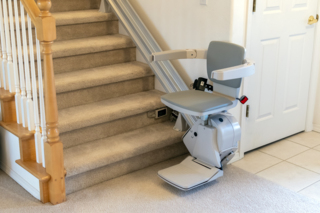¶ Introduction
A stair lift is a motorized device consisting of a chair or platform mounted on a rail installed along a staircase. It helps individuals with mobility challenges move safely up and down stairs by moving the chair or platform with the press of a button.

Stair lift at the base of a straight staircase.
Many homes have living, dining, bathing, and sleeping areas on different floors. Stair lifts allow an individual with ALS to access all of these areas for a longer period of time.
¶ Start using when…
Ascending or descending stairs requires more effort than simply holding a railing; there is a sincere need to access spaces on both floors
¶ Usage
Usage of a stair lift is straightforward. The chair itself has controls for going up or down the stairs. Some models include a remote control so that if the stair lift is already at the destination floor, it can be brought back.
Stair lifts must be left all the way at the top or all the way at the bottom so that the batteries in the chair can charge. Stair lifts that are left elsewhere along the tracking will trigger an alarm.
Stair lifts optionally include seatbelts. Users with ALS should have a seatbelt fitted, and use it for every trip.
¶ Benefits and Drawbacks
¶ Benefits
Stair lifts are among the only realistic options for ascending and descending stairs when doing so independently is not possible. Elevators are far more costly and affect the structure of the home; special stair-climbing devices require an assistant for operation.
¶ Drawbacks
¶ Limited ergonomic adjustment
Stair lifts generally lack substantial adjustments to accommodate users of varying heights. Individuals who are particularly tall or short may find it challenging to get on and off the lift or to ride it comfortably. Further, the footrests may not offer sufficient support, increasing the risk of feet slipping off during use.
¶ Limited period of suitability
An individual with quickly-progressing ALS may only benefit from using a stair lift for a short time. If adaptive equipment is needed to transfer on or off the stair lift, there would need to be two sets of this equipment: one at the top of the stairs, and another at the bottom.
¶ High acquisition cost
The stair lift market has little competition, and low demand keeps prices high.
Most stair lifts require professional installation, which is an unrecoverable cost. Some regions have very few or only one licensed installer for a given stair lift brand.
¶ Challenges with previously-owned stair lifts
Previously-owned stair lifts which do not have to go around corners may be easy to install by an amateur. Stair lifts which have to go around corners require programming of the stepper motors in the seat so that they remain level while traversing the stairs. Stair lift manufacturers only release programming information to licensed installers. Some licensed installers will refuse to touch stair lift installations that they did not do themselves.
¶ Damage to home
Installation of a stair lift may cause permanent damage to the staircase or a nearby wall. The pillars for the tracking must be drilled into the steps and screwed down.
¶ Limited resale opportunity
Stair lifts that are installed on staircases with curves and corners are generally not useable in any other building, unless they have the same staircase layout and dimensions. Some models use modular tracking, which may be possible to sell in individual pieces to multiple buyers.
¶ Further Considerations
Homes with multiple staircases that are far apart may require several stair lift installations, since one lift cannot effectively serve all areas.
Stair lifts consume very little electricity, even with regular use. Since they run on batteries during operation, the amount of current drawn from the home electrical system is only the amount needed to operate the battery charger.
Stair lifts work during power outages, but repeated use without recharging can drain the batteries and leave the user stranded partway along the staircase.
Stair lifts should not be used to evacuate in case of emergency such as fire or flood. An evacuation chair operated by an assistant should be used instead.
¶ Decision Tool
Adjust the sliders below to generate a subjective score on whether or not to purchase a stair lift.